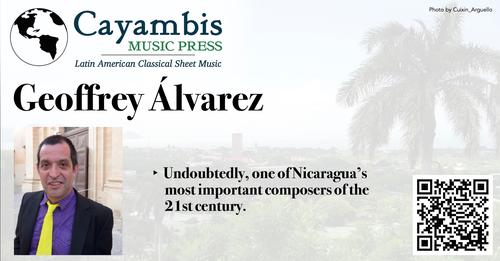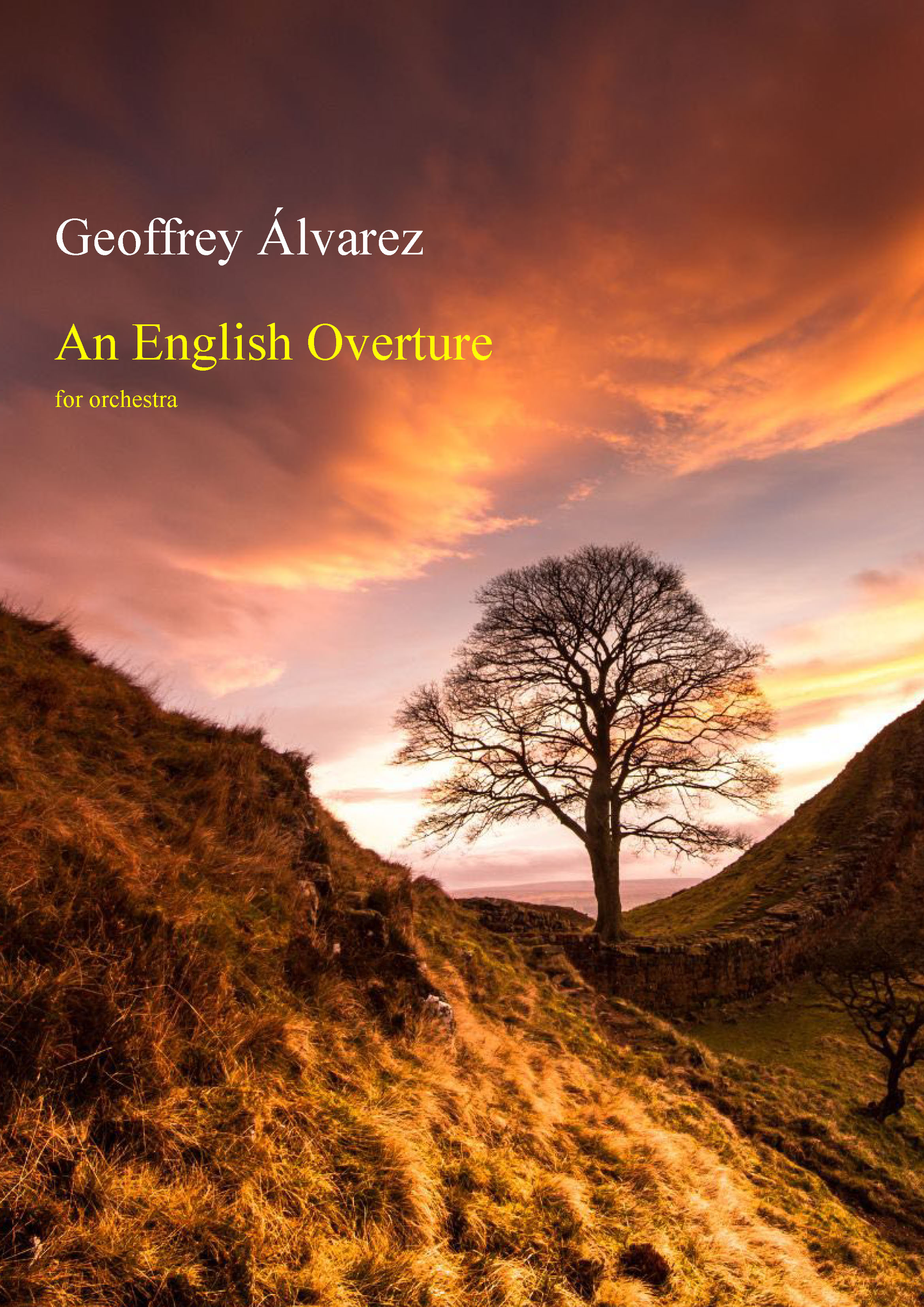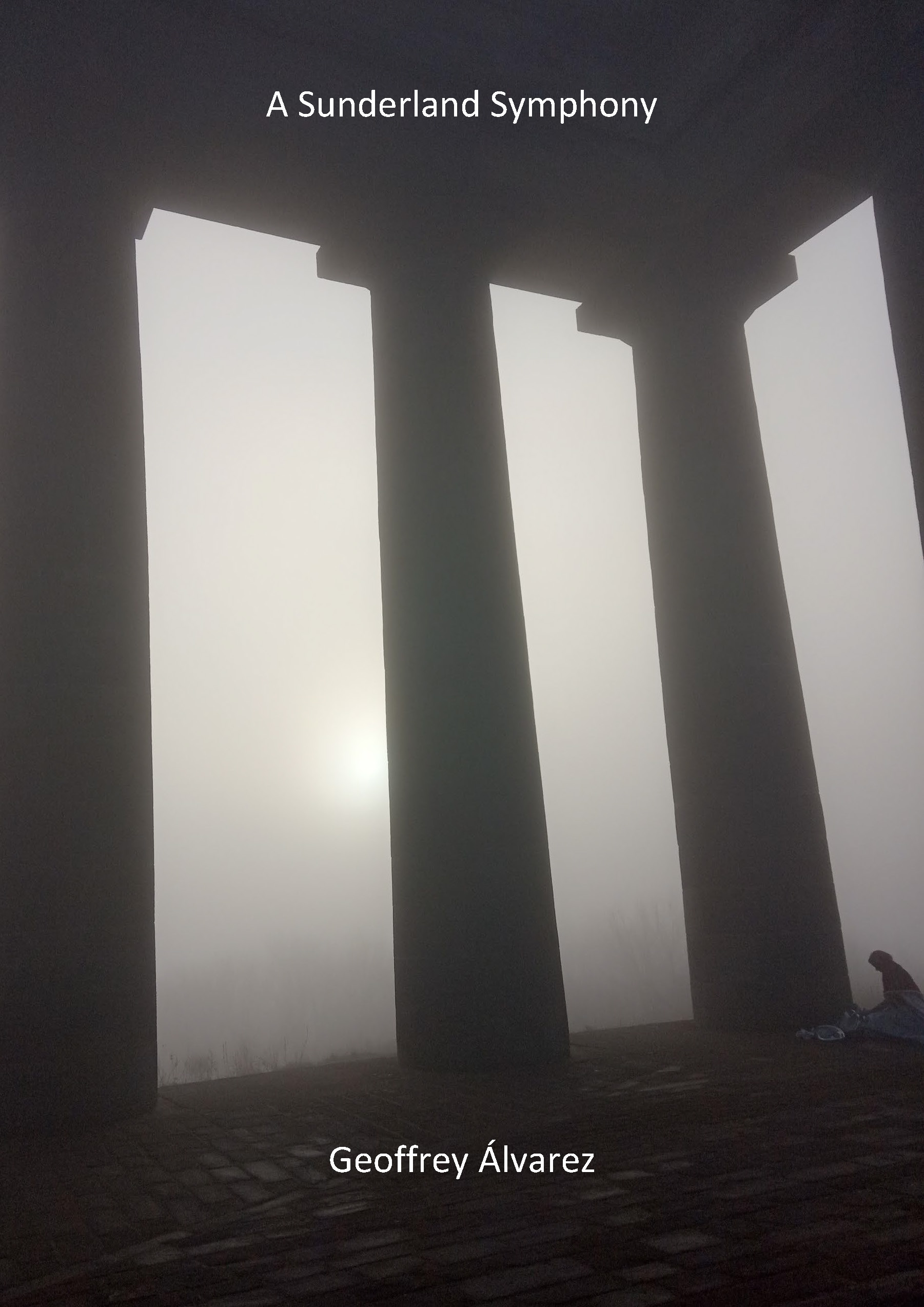Geoffrey Alvarez: orchestral works

This video is a succinct introduction to my symphonic work - its conductor Dr Pablo Rojas writes «Composición original de Geoffrey Álvarez proveniente de su Séptima Sinfonía. Interpretación en concierto el 31 de octubre de 2015 en el Centro de Documentación Musical de Andalucía en el acto de presentación del CD Bóreas Ventus».

download score
I
Composerʼs note
My ninth symphony is a setting of parts of Ernesto
Cardenal
I have
chosen to focus on five aspects of Cardenal
Musically, the five movements of the work form an arc, beginning with
an extended tone-poem dealing with creation, followed by a short
ʻscherzoʼ dealing with a tragic
accident with a sugar press, the central ʻAdagioʼ, another
In the spirit of Eisler and Brecht, the work is direct in expression, communicating with clarity and force without recourse to unnecessarily complexity. Without presenting insurmountable obstacles, there is plenty for the choral society and orchestra to enjoy.
Each of the five parts of this work may be performed alone or in association with other selected movements. Further details here.
Orchestral material available for hire or purchase from Geoffrey Alvarez

A short piece in memoriam Sycamore Gap based on this English folk melody:

Instrumentation
Piccolo, Flutes 1, 2 Oboes 1, 2 English Horn Clarinet in Eb Clarinet 1,2 in Bb Bass Clarinet in Bb Bassoons 1, 2 Contrabassoon, Horns 1, 2 in F Horns 3, 4 in F Trumpet in Eb Trumpets 1, 2 in Bb Trombones 1, 2 Bass Trombone Tuba Timpani Bass Drum Tubular Bells Tam-tam Harp Strings
Duration 7'33"
Score and performance materials
An English Overture - Download Sheet Music PDF file (scoreexchange.com)
Version for piano duet
An English Overture (youtube.com)

Sinfonija f’nofs l-opera - Sinfonia nel mezzo della
opera
Dawk li fuq l-iġfna
baħħru
The title of this opera
conceived for radio refers to ‘those who go down to the sea in ships’ is
taken from line 23 of Psalm 107, which is quoted within the text of the
work itself in episode 1, by Dun (Father) Piet delivering a sermon to
the widows and children in a church in a traditional Maltse fishing
village.
DUN PIET:...Iva, ħuti għeżież! U kif hi l-użanza tagħna meta jersaq
Novembru, ħdejn il-bieb ewlieni waħħalna karta bl-ismijiet tas-sajjieda
-issirijietna, qrabatna, ħbiebna -li tilfu ħajjithom fuq il-baħar waqt
li kienu jitħabtu biex jaqilgħu l-ħobża ta' kuljam għal familthom.
Ejjew, għeżiez ħuti, ma ninsewx, kif jgħidilna s-Salmista, li dawk li
fuq l-iġfna jbaħħru […]
DUN PIET:..Yes, dear friends! And as is our custom when November
approaches, near the main gate we pasted papers with the names of
fishermen belonging to us,our relatives,our friends who lost their lives
at sea while they were struggling to make ends meet for their families.
Let us, dear brethren, do not forget, and the Psalmist tells us, those
who sail in ships, to do business on the endless seas, have seen the
wonderous works of the Lord on the seabed. .
The social and economic organisation of this tradition fishing community are
under investigation by post-graduate anthropologist Mark Borg who is
unable to keep an objective distance
from his subject, principally due to
his attachment to Marija, who is already promissed to Ġanni.
Mark atones for his transgression by offering his life to save
his rival Ġanni and the rest of the crew
during a fishing expedition uttering the phrase from A Tale of
Two Cities: “It is a far, far better thing that I do, than I have
ever done; it is a far, far better rest that I go to, than I have ever
known.”
Both the opera and the original radio
play has occassional recourse to music, from Cesar Frank’s
Panis Angelicus
to the traditional Maltese ballade - L-għana
tal-fatt: l’istorija ta Arturo u Marija.
In the opera, the lullaby
Orqod, orqod, recorded in Folk Songs and Music from Malta
Folkways Records
FM4047 and
notated by Charles Camilleri in Maltese Oral Poetry and Folk Music,
Malta University Publishers Ltd. is also included, sung by the sea,
soothing the narrator during various parts of the opera.
The Sinfonija comes at the
beginning of the eighth episode and represents the gradual agitation of
the seascape as a fishing expedition including Mark and Ġanni as they
search the oċean for lampuki leading to the tragic storm of the eighth
episode. It also functions as a traditional overture, although it is
placed in the middle of the work, reprising most of the main themes
which occur in the following order:
(1)
The lullaby
Orqod, orqod given initially to the piccolo
(2)
The souls of the
departed as ‘stars’ on the glockenspiel
(3)
Ġanni’s theme
heard on the oboe
(4)
The love of Mark
for Marija
(5)
The engagment of
Marija to Ġanni
(6)
Panis Angelicus
(7)
Maija’s anger
(8) Ave Maris Stella plainsong
(9) L-għana tal-fatt: l’istorija ta Arturo u Marija '
(10)
Storm
theme characterised by string glissandi and unison figures.
.
Orchestration
Piccolo,
2
Flutes,
2
Oboes,
Cor
Anglais,
Eb
Clarinet,
Bb flat
Clarinet
Percussion:
2 players: Bass
Drum,
Tenor
Drum,
Snare
Drum
Duration: circa 14 minutes
The original radioplay Dawk li fuq l-iġfna jbaħħru was awarded the
Malta Broadcasting Authority
Best Radioplay for the year 2002-03:
https://www.midseabooks.com/publications_detail.aspx?pid=11686#
The score of the complete opera can be downloaded here:

A Sunderland Symphony is a choral symphony in five movements.
Full details of all five movement here.
Instrumentation
Piccolo, 2
Flutes, Alto Flute, 2 Oboes, Cor Anglais, Clarinet in Eb,
2 Clarinets
in Bb,
Bass Clarinet in Bb,
Bassoons,Contrabassoon,
4 Horns in F, Piccolo Trumpet in Eb,
2
Timpani (two
players)
Piano, 8 church bells tuned to
the diatonic octave
Alternative versions for G major and F major bells is also available.
Soprano, Mezzo-Soprano, Baritone, SSAATTBB Chorus
Full Score of complete work
version ending in D
-
orchestral material
Full Score of complete work version
ending in G
-
orchestral material
Full Score of complete work version
ending in F
-
orchestral material
Vocal Score with pianoforte duet reduction -
version in
D,
G &
F

1: Nil desperandum auspice
“Don’t despair, trust in God.” – a celebration of Sunderland’s city motto
accompanied by a stylised boom redolent of the foghorn of the Souter light
house, the strident call of the
great herring gulls
and the sea herself.
This is both
the first movement of A Sunderland
which can be performed independently
of the complete work, as may all the other movements.
video realisation of vocal
parts
Score of overture
2: The brassic Fish Lass
For Mezzo-soprano, Soprano and orchestra
A fish lass (or wife) haggles with a hinny (lady) over her produce on a brassic (freezing cold) day.
video realisation of vocal and string parts
3: Jabberwocky: an uffish Fugue
The first verse
a publication Lewis Carroll wrote
for his family.
The rest of the poem was written in Whitburn,
based on
two
the Lambton and Sockburn
worms.
video realisation
4: Marra
for Alto, Bass, Chorus
The text of Marra is
from the Ryhope Little plaque
detailing with the life of the wife and
mother of pitmen, Sarah Seed.
video realisation of vocal parts
5: Bede’s Death Song
For Bass, Chorus, Organ, Church Bells and Orchestra
The Venerable
Bede died on Thursday, 26 May 735, Ascension Day, on the floor
of his cell in Jarrow singing Glory be to the Father and to the
Son and to the Holy Spirit. That night he dictated a final
sentence to the scribe, a boy named Wilberht, and died
soon afterwards. Whilst the poem is not
definitely attributed to Bede, this orchestral song imagines that Bede is
indeed composing this poem on his deathbed, taking
Contact Geoffrey Álvarez for Performance materials.
video realisation of vocal parts of G version
video realisation of vocal parts of F version
score of G version
score of F version

Instrumentation
2 Flutes 2 Oboes
2 Clarinets in Bb 2 Bassoons
2 Horns F 2
Trumpets in Bb
The Dark Night of the Soul
A ravenous
ghoul,
The serpent of
destruction and rebirth,
Coils around the
dark night-soul:
An all pervasive
passacaglia
Suffocating and
corrupting tired flesh.
The basest
material survives
This
putrefaction,
Awaiting dawn’s
rose...
© Copyright Geoffrey Álvarez 2015
La Noche Oscura del Alma is Geoffrey Álvarez’ tenth symphony, the first of a cycle exploring the four stages of the alchemical Great Work, or Magnum Opus, the first being the ʻnigredo’ or
ʻblackening’, poetically portrayed in the poem above. The twelfth, Citrinitas, is already composed, and is dedicated to organist Kevin Bowyer who has already premiered his eighth symphony: St Paul's Shipwreck. The eleventh, Whitening Winds, for symphonic wind orchestra, and the thirteenth, The Chemical Wedding, for organ and large orchestra are in preparation.

Les Noces Chemiques
represents
the final stage of the Alchemical Great
Work: the rubedo (redening) – a process involving the
philosopher's stone, described by
Abū Mūsā Jābir ibn Ḥayyān, (born c. 721,
Ṭūs, Iran-died c. 815, Al’ Kūfah, Iraq),
a father of chemistry whose name is often
associated with the term ‘gibberish’
whilst the
musical backbone of this work is the gene
detailed in
Lawn RM, Efstratiadis A, O’Connell C,
Maniatis T: The nucleotide sequence of the human beta-globin gene. Cell.
1980 Oct;21(3):647-51
Note on the biological structure of the piece.
The main body of the work begins and ends with a musical representation
of the spiral form of the double helix of
Instrumentation
Piccolo
orchestral material available
from

excerpt
Instrumentation
2 flutes, piccolo, 2 oboes, cor anglais,
2 clarinets ,2 bassoons, 4 horns, 2 trumpets,
3 trombones, tuba, timpani, bass drum,
cymbals, tambourine, tubular bells, xylophone,
piano, harp, strings
All instruments notated at written pitch
duration circa 24
Composerʼs note
This work was premiered in its original form in St Giles, Cripplegate under my direction by the Alvarez Chamber Orchestra in 1981. The revision was undertaken in 2010. The work is the nearest to traditional symphonic form I have attempted and was composed at a time whilst I was still a student at the Royal Academy of Music avidly absorbing the music of a variety of other composers: Waltonʼs First Symphony and Lutoslawskiʼs Concerto for Orchestra, for instance, are strong influences in this and following movement, Passacaglia, whilst the Bartok of the Dance Suite and Bluebeardʼs Castle can be heard in the last turbulent movement: Totentanz. Of significance to my subsequent development was the simultaneous presentation of the first and second subject of the exposition of the first movement, which had been heard sequentially, in the conventional manner in the exposition.
Orchestral material available for hire or purchase from Geoffrey Alvarez
Three pieces from the King’s Last Prophecy
Overture
Instrumentation
piccolo, 2 flutes, 2 oboes, cor anglais, 2 clarinets,
bass clarinet, 2 bassoons, contrabassoon 4 horns,
2 trumpets, 2 tenor trombones, bass trombone, tuba
timpani. percussion

Instrumentation
piccolo, 2 flutes, 2 oboes, cor anglais, 2 clarinets, bass clarinet,
2 bassoons, contrabassoon, 4 horns, 2 trumpets, 2 tenor trombones, bass trombone, tuba
timpani. percussion
2 tom toms, xylorimba glockenspiel, vibraphone, tubular bells, harp, pianoforte, strings
Illustration: the Kogi
of Columbia – subject of the King
3:El corazón del mundo
Aria for soprano and orchestra
The poem El corazón del mundo is from Masque and Marriage, the third part of a five opera dream based on the ‘Weltanschauung’ of the Kogi of Colombia: The King’s Last Prophecy. There are two main sources: Los Kogi de La Sierra Nevada by Reichel Dolmatoff and The Heart of the World; the latter is both a documentary and a book by Alan Ereira. Alan Ereira notes the universal resonance of Kogi beliefs in his work cited above, finding echoes in other world religions: the Madrona, for instance, mentioned in the song, is the archetype of the Great Mother found in cultures as diverse as Ancient Mexico, Old Europe, India: the Virgin of the Catholic world.
Orchestral material available for hire or purchase from Geoffrey Alvarez

digital realisation • excerpt • duration circa 14 minutes
Instrumentation
Piccolo, 2 Flutes, 2 Oboes (2nd doubling Cor Anglais), 2 Clarinets (2nd doubling Bass Clarinet)
Bassoon, Contrabassoon, 4 Horns, 2 Trumpets, 2 Tenor Trombones, Tuba, Timpani,
Percussion: two players Snare Drum, Bass Drum, Cymbals, Tubular Bells, Xylophone,
Piano, Harp, Strings
Orchestral material available for hire or purchase from Geoffrey Alvarez
Composerʼs Note
My Seventh Symphony, ʻHyperboreaʼ, is structured around the number seven, sacred to the seven vowel God JIEVOAŌ according to Robert Graves: The Lord of the seven day week was ʻDisʼ, the transcendental God of the Hyperboreans, each day symbolised by one of the seven vowels introduced to correspond to the additional two strings introduced to the five course lyre in the 4th century by Simonides, the subject of my address to the Robert Graves White Goddess Conference in Manchester University and subsequently published in Gravesiana: the Journal of the Robert Graves Society.
Download paper here.
He cannot walk in the brazen sky,
but among
those goods that we of mortality attain to he goes
the whole
way. Never on foot or ship could you find
the marvelous road to the feast
of the- Hyperboreans.
Perseus came to them once, a leader of men,
entered their houses,
found them making hecatombs of asses
to
Apollo, who in their joyance and favourable
speech rejoices, and smiles to
see
the rampant lust of the lewd beasts.
Never the Muse is absent
from their ways: lyres clash, and the flutes cry,
and everywhere
maiden choruses whirling.
They bind their hair in golden laurel and take
their holiday.
Neither disease nor bitter old age is mixed
in their
sacred blood; far from labor and battle
they live; they escape Nemesis,
the over just.
From Pindar: Tenth Phythian Ode 498 b.c.

Instrumentation
Piccolo, 2 Flutes, 2 Oboes, Cor Anglais, 2 Clarinets, Bass Clarinet,
2 Bassoons, Contrabassoon, 4 Horns, 2 Trumpets, 3 Trombones, Tuba,
Timpani – two players, Percussion – five players, Harp, Pianoforte, Strings
Duration c. 47 minutes
Composerʼs note
The result of my work on music on Gravesʼ grammar of poetic myth, The White Goddess is a song cycle for bass and chamber orchestra, My Last Muse, setting six of Gravesʼ poems inspired by Julia Simonne, his ʻlast museʼ and my Second Symphony: The Five Seasons, whose structure is based on a presentation of Gravesʼ Celtic Five-Season Year expressed as the five vowels of the Beth-Luis-Nion alphabet, each season assigned to a vowel and corresponding tree - the third month at the top of the diagram above, for instance, is Ura, the Heather Goddess (Uroica in Gallic).
Each season is also divided into three months, also associated with certain trees, and five intercalary days, associated with the birthdays of the five principle Egyptian deities, Osiris, Horus, Set, Isis and Nephtys, and the days at which Thoth beat the Moon Goddess Isis at draughts; whilst some may find nothing new under the sun, there is plenty to be discovered
under the moon.

Orchestral material
available for hire or purchase from
Geoffrey
Alvarez
concertino for piano
and chamber orchestra

This piece was awarded a prize in the
Tansman 6th International Competition of Musical Personalities, Composers Competition, Lodz 2006.
The adjudicators included Krauze, Penderecki, Nyman, Holliger and Zur.
He was pianoforte soloist in this work with the Arthur Rubenstein Philharmonic Orchestra in Lodz, conducted by Luca Pfaff (pictured on the right)
Orchestral material available for hire or purchase from Geoffrey Alvarez